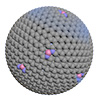| Apr 30, 2025 |
Researchers have created a manganese-based nanozyme that enables both near-infrared imaging and precise catalytic treatment of tumors in cells and animal models.
(Nanowerk News) A research team led by Prof. WANG Hui from the Hefei Institutes of Physical Science (HFIPS), Chinese Academy of Sciences (CAS), in collaboration with teams led by Prof. QIAN Junchao from HFIPS and Prof. Qu Songnan from the University of Macau, has successfully developed a novel low-coordination single-atom manganese nanozyme using a unique “molecular carbonization-reduction” strategy.
|
|
The work, supported by electron paramagnetic resonance (EPR) measurements at the Steady-State Strong Magnetic Field Facility (SHMFF), has been published in Advanced Science (“Low-Coordination Configuration Single-Atom Manganese Nanozymes for NIR-Imaging-Oriented Efficient Catalytic Oncotherapy”).
|
 |
| Schematic diagram of efficient tumor catalytic therapy mediated by SA Mn-CDs with near-infrared fluorescence imaging. (Image: JIN Peiwei)
|
|
Traditional metal-nitrogen (M-Nx) single-atom catalysts are typically found in stable M-N₄ configurations. However, these structures have limited active sites and tend to lose intermediate products during catalytic processes due to weak substrate binding, which hampers overall catalytic performance.
|
|
To address this, the team developed a new strategy that carefully selects molecular ligands to chelate with manganese atoms, creating single-atom manganese-doped carbon dots (SA Mn-CDs) with a low-coordinated Mn-N₂ configuration.
|
|
These ultrasmall SA Mn-CDs feature atomically dispersed manganese centers, excellent water solubility, and strong biocompatibility. More importantly, they demonstrate high peroxidase-like catalytic activity by effectively mediating Fenton-like reactions—a performance confirmed via advanced EPR analysis.
|
|
The material also exhibits remarkable near-infrared (NIR) fluorescence imaging capabilities at both cellular and animal levels, enabling precise, imaging-guided tumor catalytic therapy.
|
|
This study highlights the immense potential of low-coordination manganese-based nanozymes for NIR-guided cancer treatment and underscores the critical importance of atomic-level structural design in advancing single-atom catalytic therapy for biomedical applications.
|


